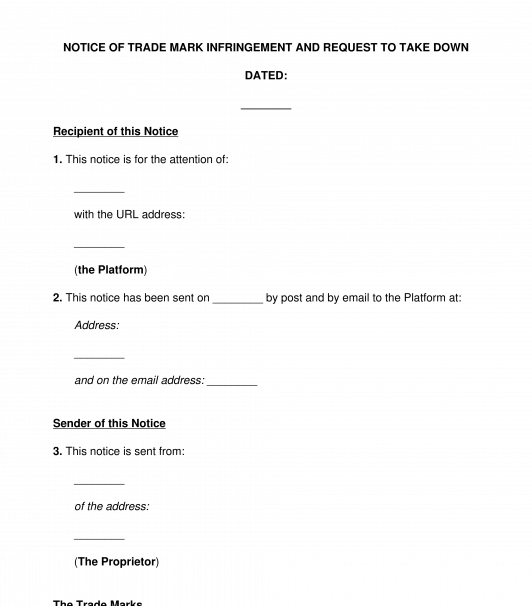 08/10/2025
08/10/2025

Answer a few questions and your document is created automatically.

Your document is ready! You will receive it in Word and PDF formats. You will be able to modify it.

 08/10/2025
08/10/2025
 Word and PDF
Word and PDF
 4 pages
4 pages
This document is a formal notice which can be used by an owner of a UK registered trade mark, in order to notify an online platform (internet service provider), that it is hosting material which infringes the trade mark and which targets UK consumers. This type of notice is often referred to as a 'take-down request'.
Typically, this type of notice will be used where it has not been possible to identify or contact the individual platform user who is committing the infringement or where previous requests have been ignored by the user. This notice can therefore be sent to the platform/internet service provider in order to request the removal of the content.
Trade Marks
A trade mark is a sign which is used by a business to represent its brand and products.
A trade mark may take many different forms. For example, a trade mark may consist of:
This document is designed for use where the trade mark concerned is a UK registered trade mark. A trade mark may be registered in the United Kingdom via the UK Intellectual Property Office. When a trade mark is registered, it will be registered for use on certain goods and/or services.
For other forms of Intellectual Property, a different type of notice should be used. We currently have a notice which may be used for online copyright infringement.
Trade Mark Infringement
For trade mark infringement which takes place on an online platform, there are generally three legal types of infringement which will be relied upon:
(a) An identical mark has been used in relation to identical goods/services.
This type of infringement occurs when the trade mark owner can show that an identical mark has been used on the same goods/services that their trade mark is registered for use on. A common example of this type of infringement would include fake/counterfeit designer clothing.
(b) A similar or identical mark has been used in relation to similar or identical goods/services.
This type of infringement occurs where the trade mark owner can show that a similar mark has been used on the same goods/services that their trade mark is registered for use on OR where an identical mark has been used on similar goods/services. In these circumstances, the use of this mark will have created a possibility of the public being confused as to the origin of the goods/services and that the marks could be considered to be associated.
(c) A similar or identical mark has been other on other goods/services (unfair advantage and detrimental effect)
This type of infringement occurs when the trade mark owner can show that a similar or identical mark has been used, but not on any similar or identical goods/services. The trade mark owner will be required to prove that an unfair advantage is taken over their trade mark and that there has been a detrimental effect on the character and reputation of their trade mark.
The owner of the trade mark will wish to ensure that it is certain that the infringement has occurred, and of the relevant ground(s) they rely upon. This is because legal action can be taken against a person if they have made an unjustified threat of intellectual property right infringement.
This notice should be completed with the factually correct information. Proof of the trade mark registration will be attached to the notice. Copies of the infringing content can be exhibited to the notice.
Once the notice has been completed, it can be signed and sent by post or electronically signed and sent by email (or both). The website of the online platform should be checked to determine whether it specifies the particular method by which any such notices should be sent.
A timeframe for the removal of the content will be provided to the platform. If the platform does not respond or does not remove the content, the trade mark owner may wish to consider sending a letter before proceedings and making an application to court for an injunction to order the removal of the content.
The main legal provision which governs trade marks and trade mark infringement is the Trade Marks Act 1994.
The provisions of the Intellectual Property (Unjustified Threats) Act 2017 is also applicable to trade marks.
The Electronic Commerce (EC Directive) Regulations 2002, SI 2002/2013 sets out important legal provisions regarding the service of this type of notice.
You fill out a form. The document is created before your eyes as you respond to the questions.
At the end, you receive it in Word and PDF formats. You can modify it and reuse it.
A guide to help you: How to Send a Letter
Notice of Online Trade Mark Infringement - Template
Country: United Kingdom